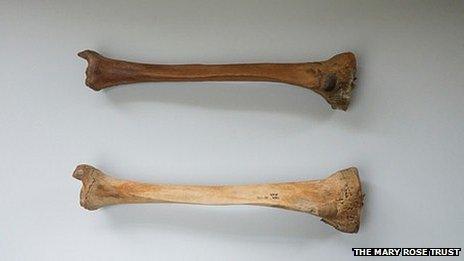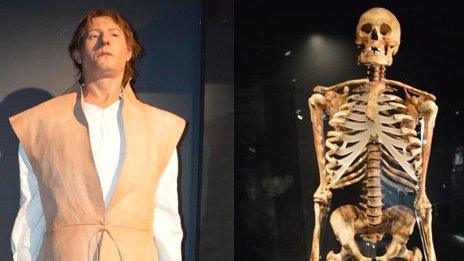Mary Rose sailors had childhood rickets, study finds
- Published

Two tibia bones taken from sailors on the Mary Rose shows one (darker) has rickets and the other (lighter) not
Many sailors who died on Henry VIII's warship Mary Rose had rickets in childhood, new research has found.
The vessel sank in the Solent, off Hampshire, on 19 July 1545, resulting in the deaths of more than 400 men.
Using lasers, scientists were able to identify the disease, often contracted due to poor diet, without damaging the sailors' bones.
The new technique can allow a study of the disease's prevalence in the past and help detect modern-day cases.

The skeleton of an archer was one of 92 complete ones found on the wreck and is on display at the Mary Rose Museum in Portsmouth
The Tudor ship sank while leading an attack on a French invasion fleet and was raised from the sea bed in 1982.
The sailors' bones were analysed using Raman spectroscopy, a non-destructive laser technology.
Jemma Kerns, one of the scientists who conducted the study, said: "This is the first time that this laser technology has been used to study bone disease in archaeological human bone.
"We have identified chemical changes in the bones, without damaging them.
"There is strong evidence to suggest that many of the sailors had suffered from childhood rickets and we hope to apply the Raman technique to the study of modern-day rickets."
Alex Hildred, curator of human remains at the Mary Rose Trust, said: "The human remains have potential to make a contribution to the public through research, education, display and interpretation.
"Their use to confirm the presence and prevalence of metabolic bone disease in the 16th Century is one of these contributions."
The results of the study, conducted at the Royal National Orthopaedic Hospital in London and led by Prof Allen Goodship, has been published in the Journal of Archaeological Science.
The project was one of a number funded through a £1.7m grant from the Engineering and Physical Sciences Research Council.
- Published30 May 2013
- Published11 October 2012

- Published19 February 2011